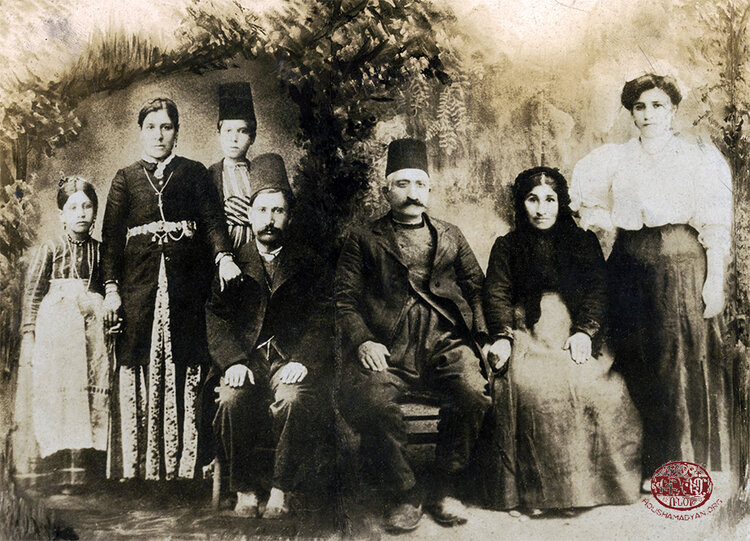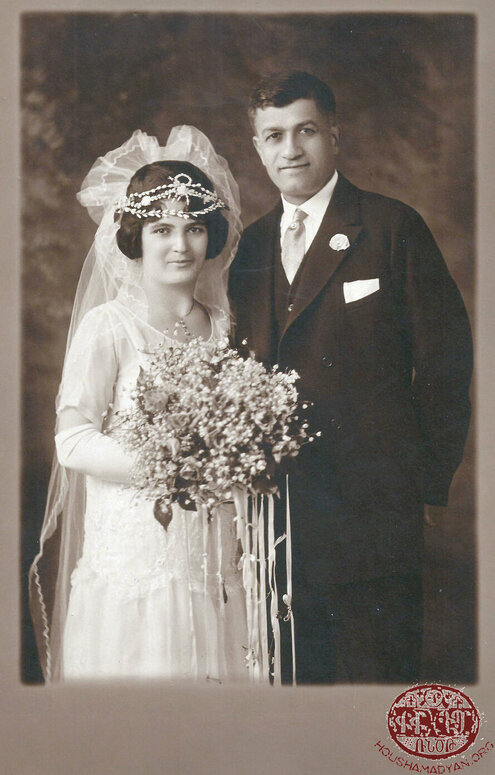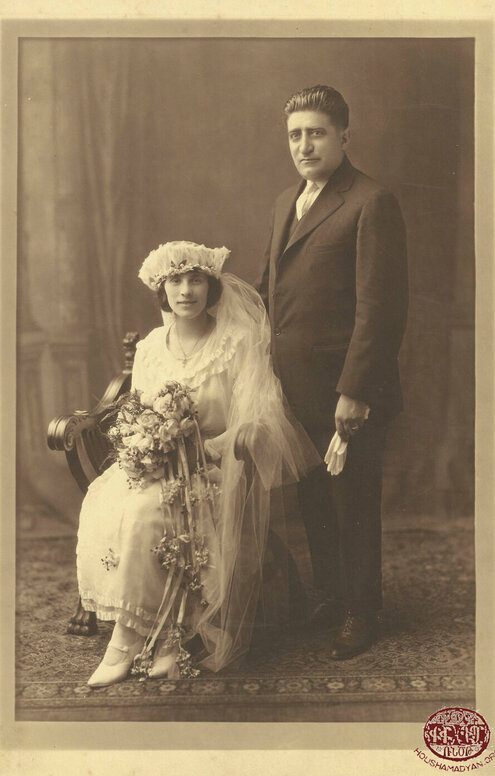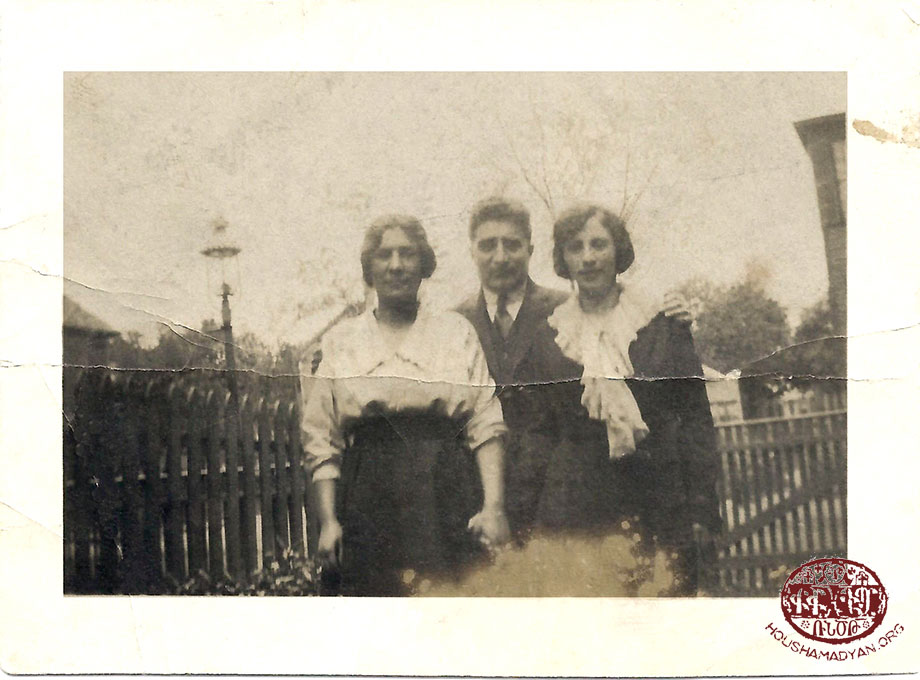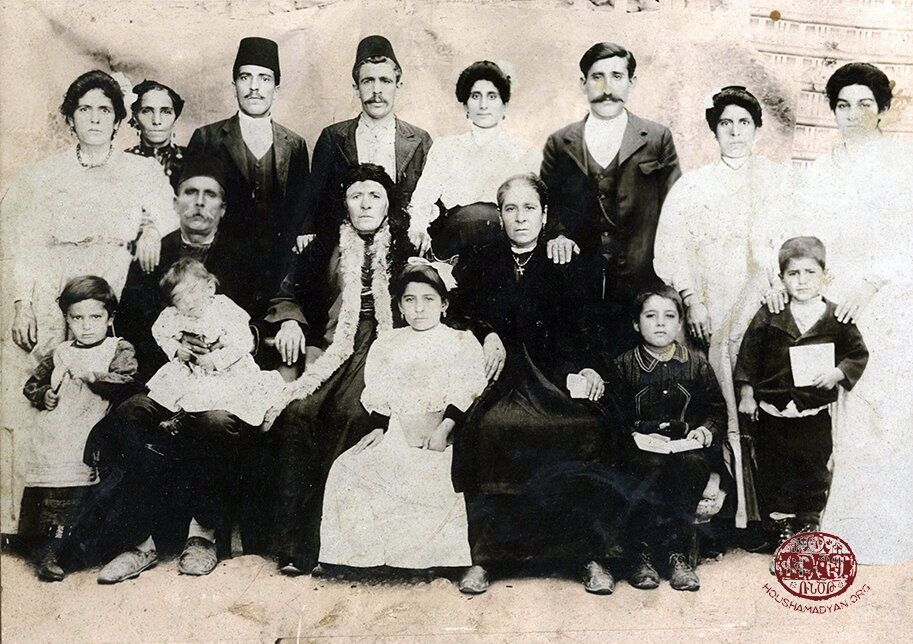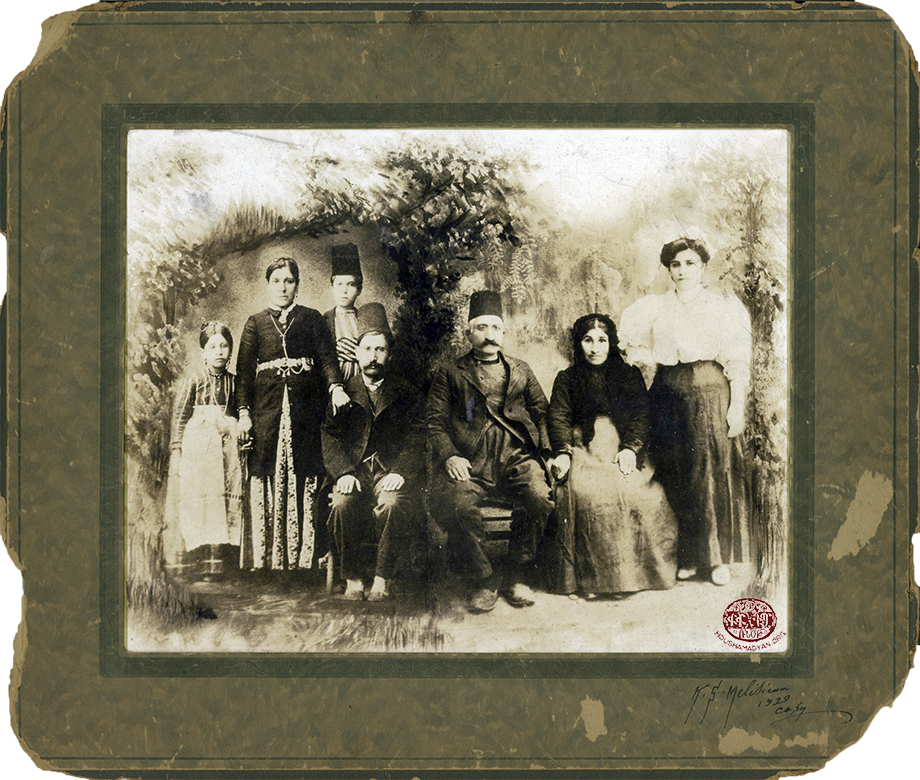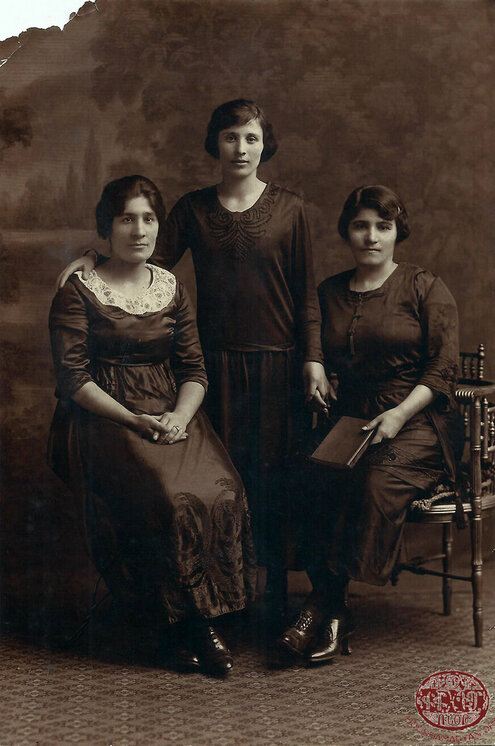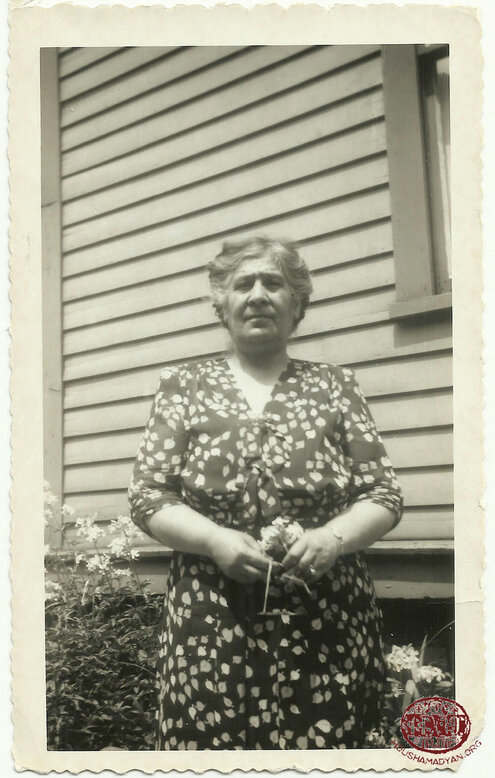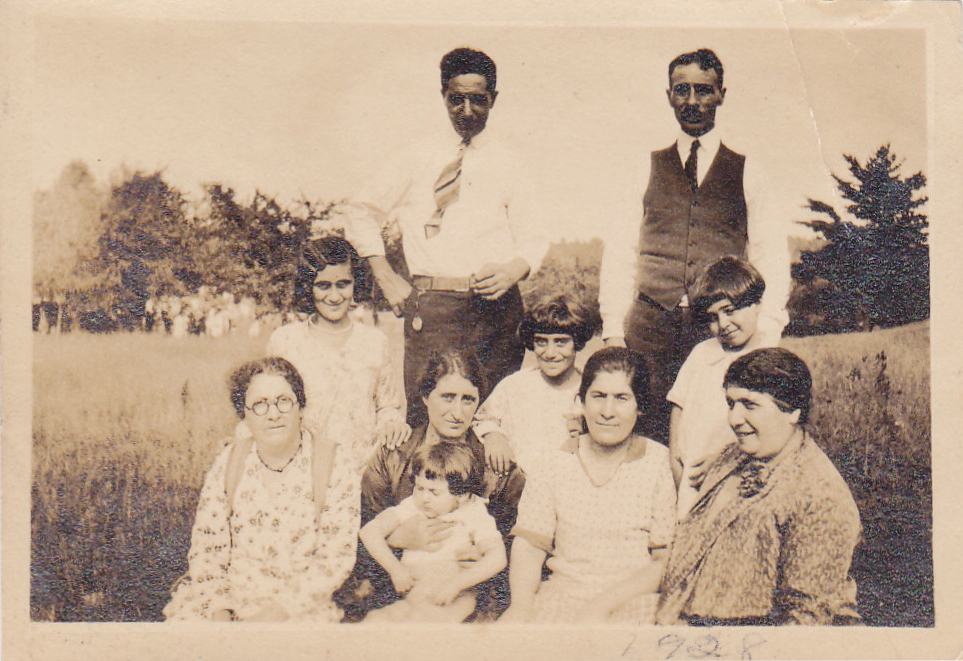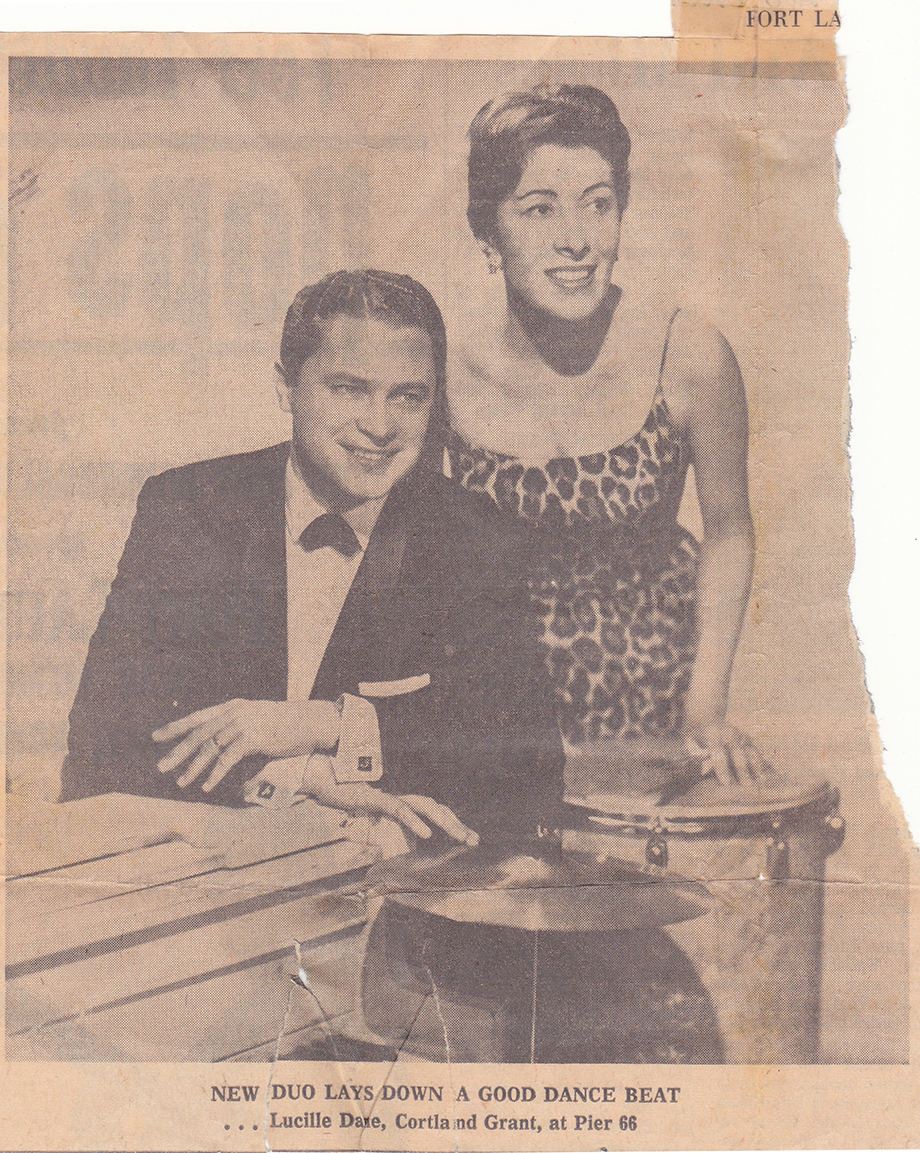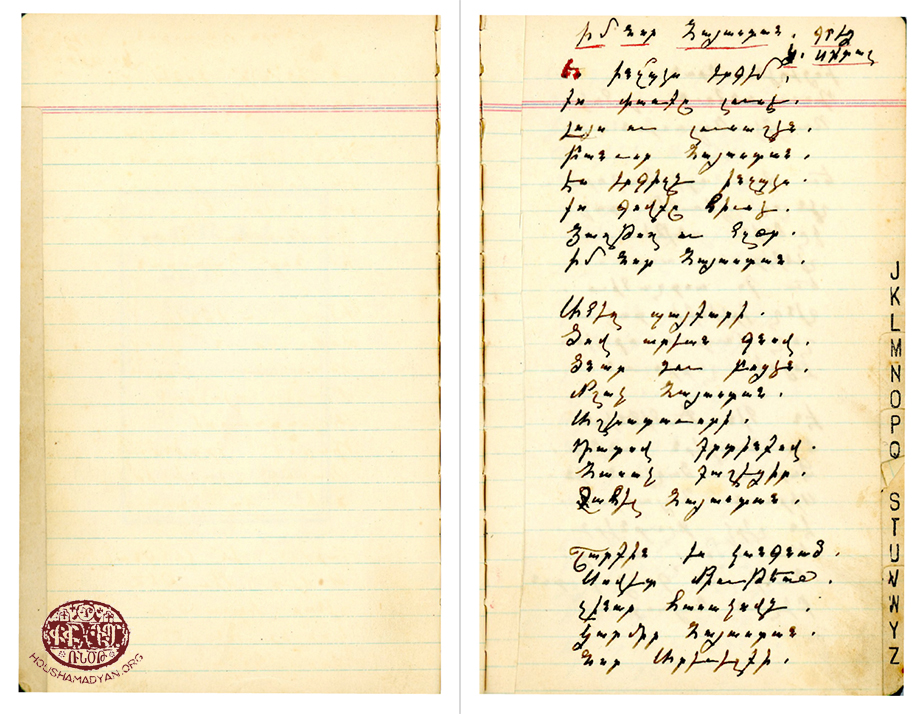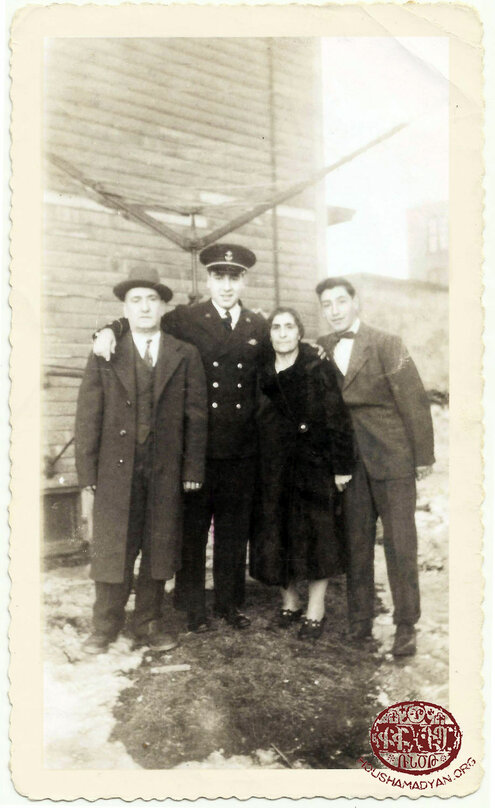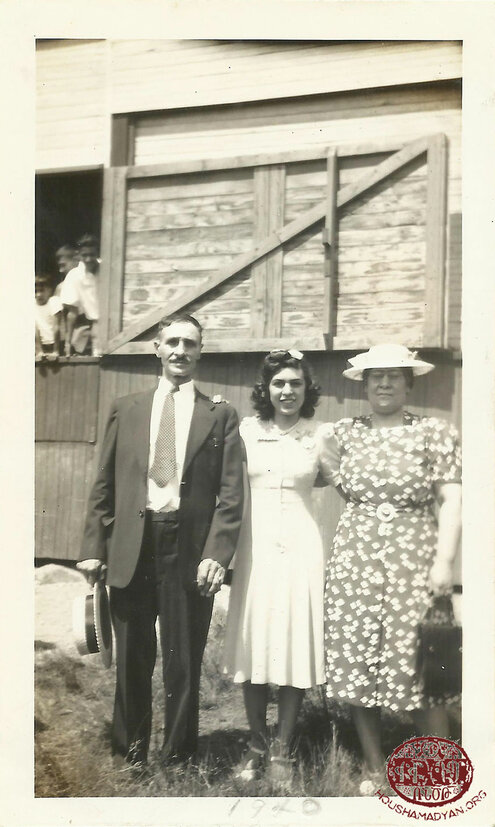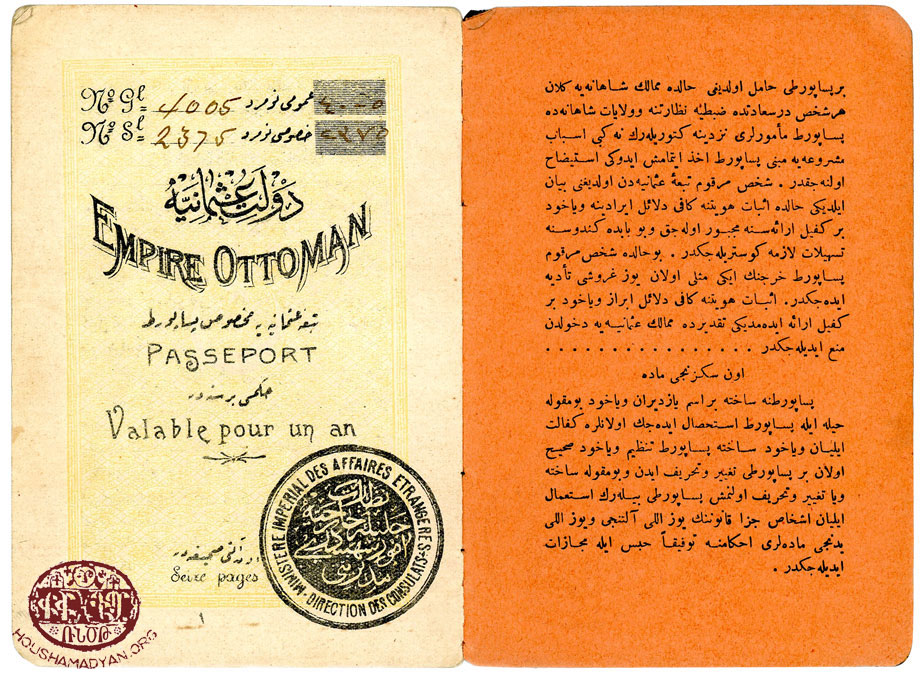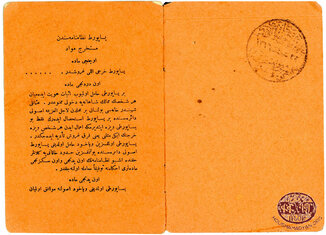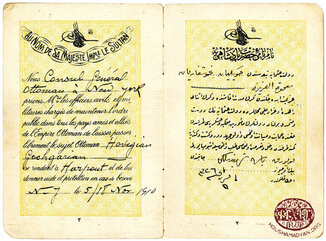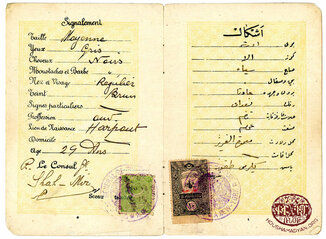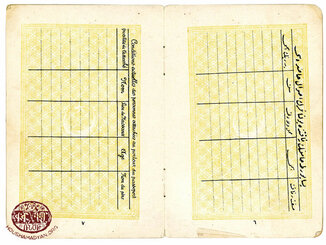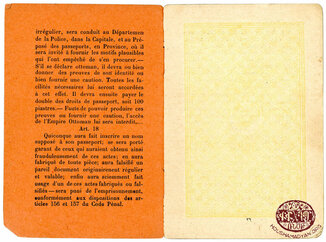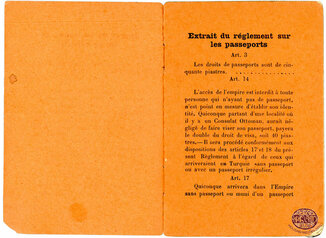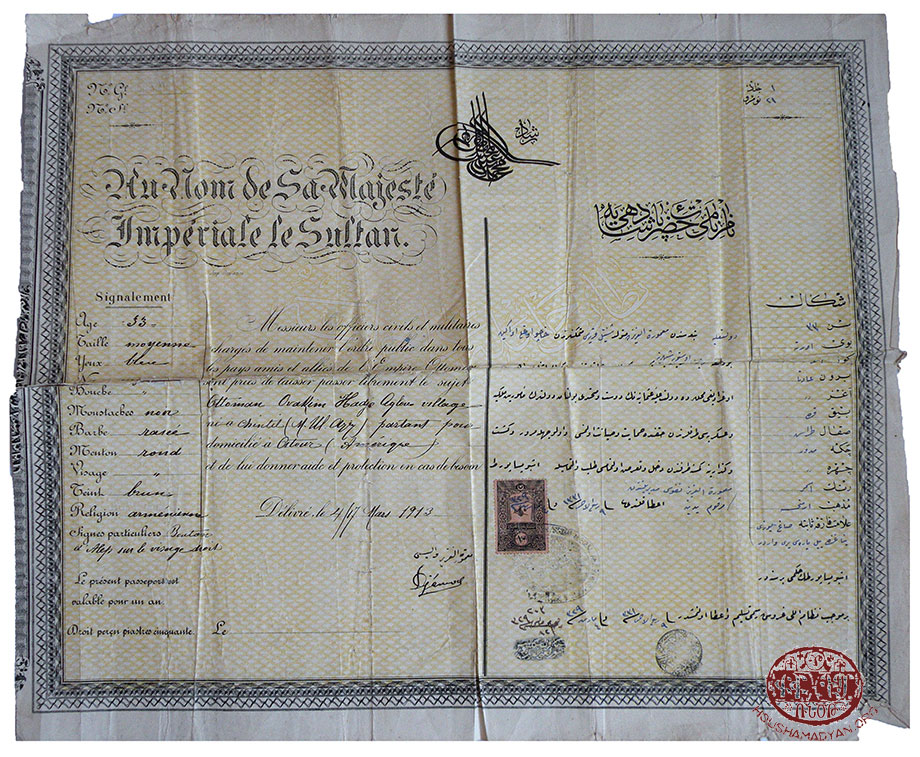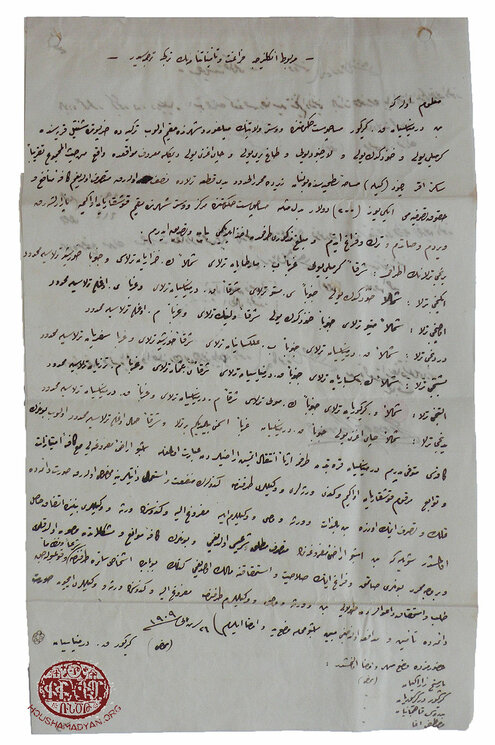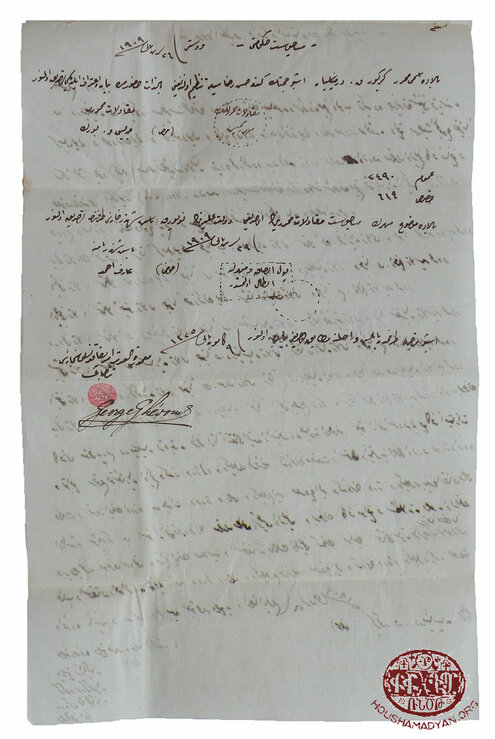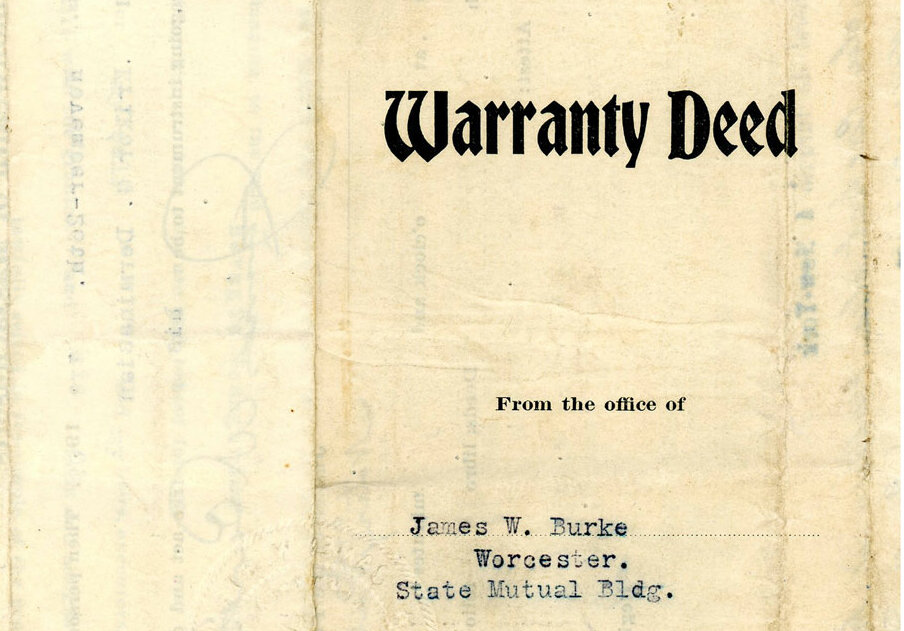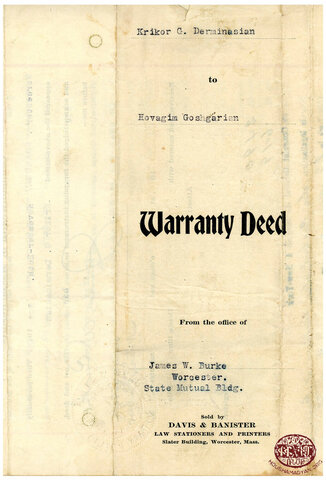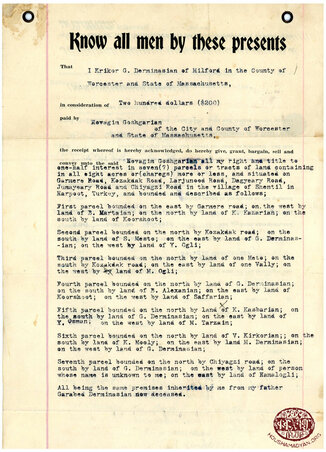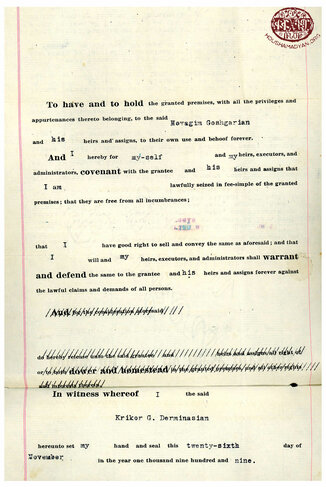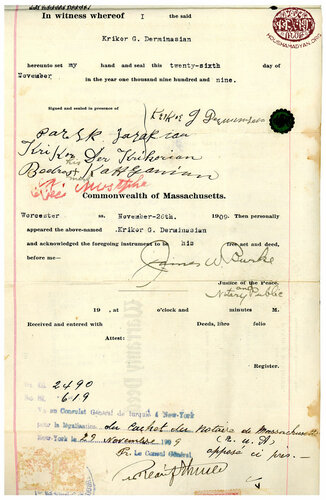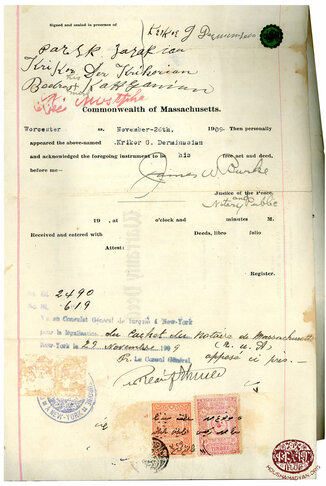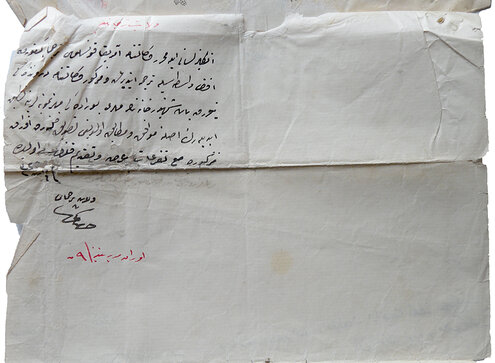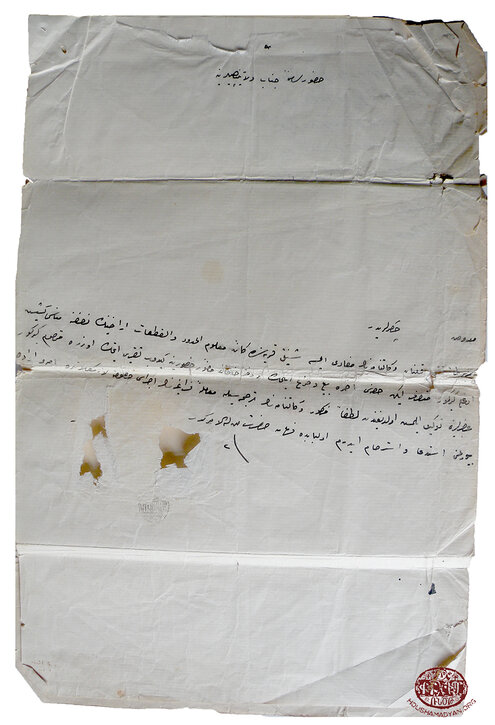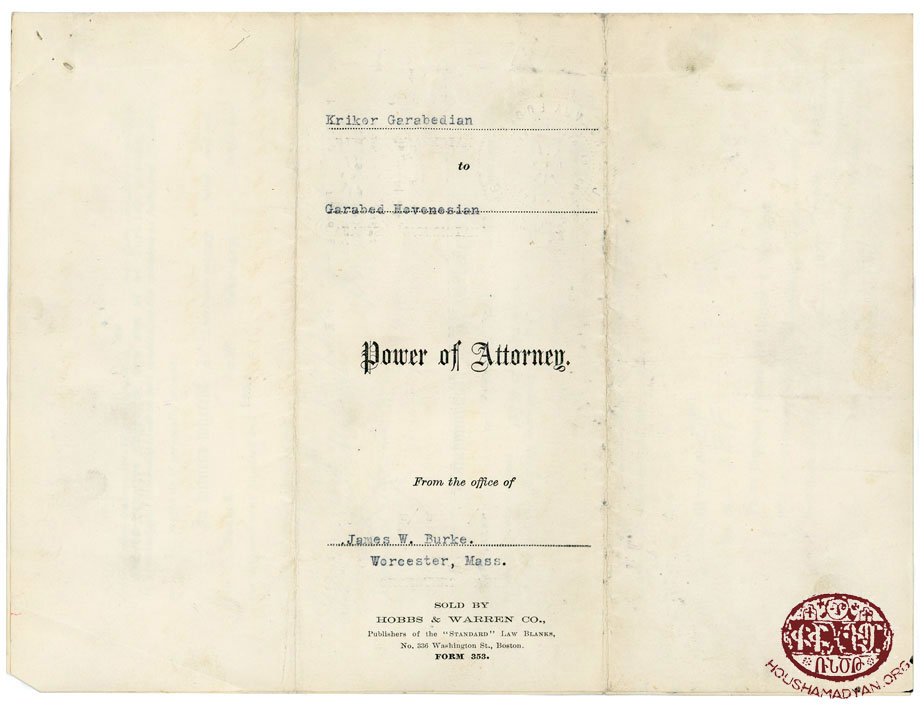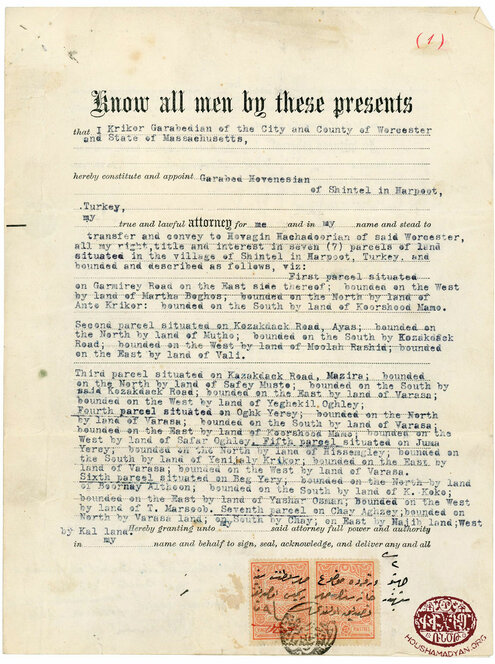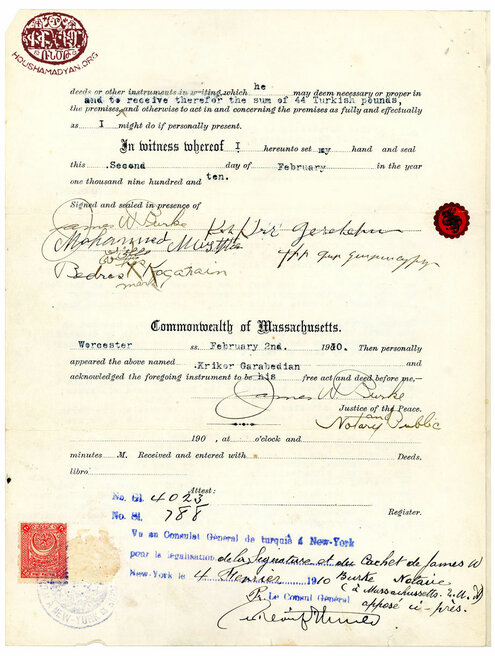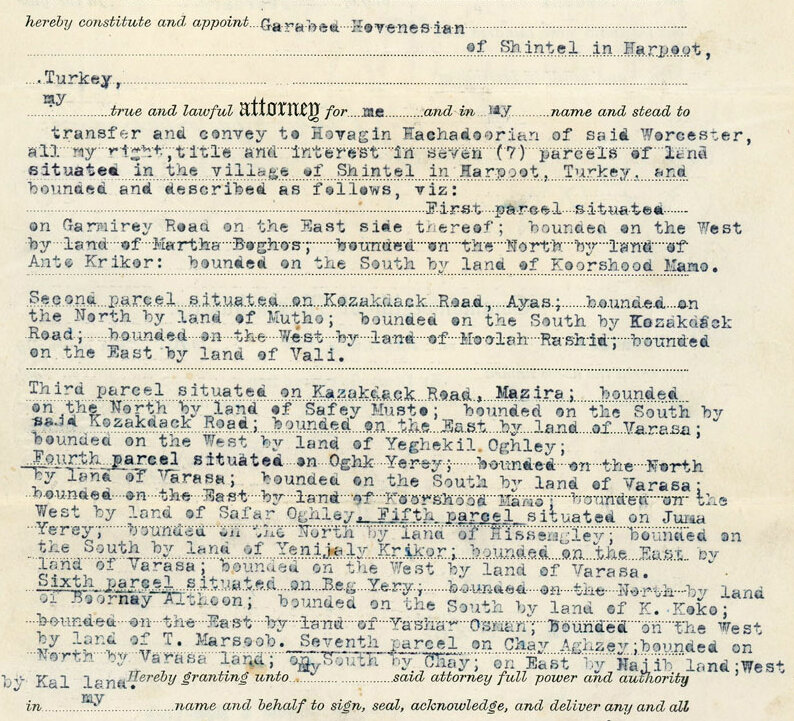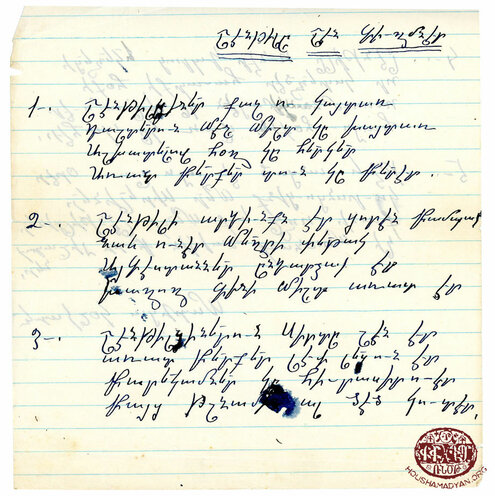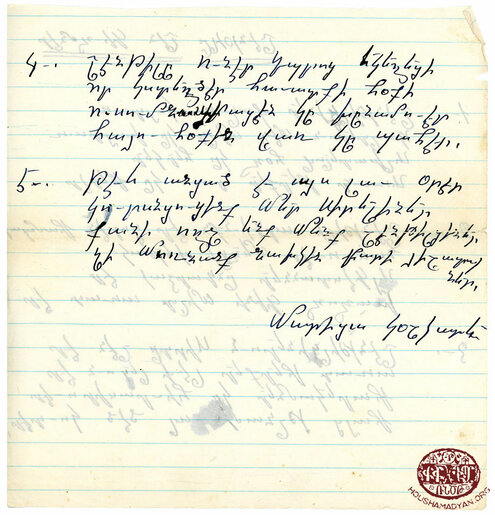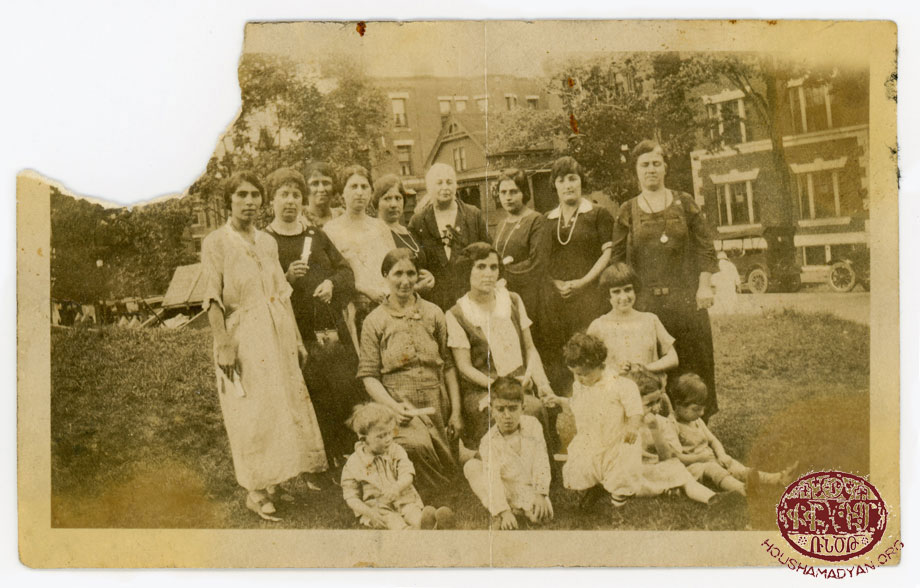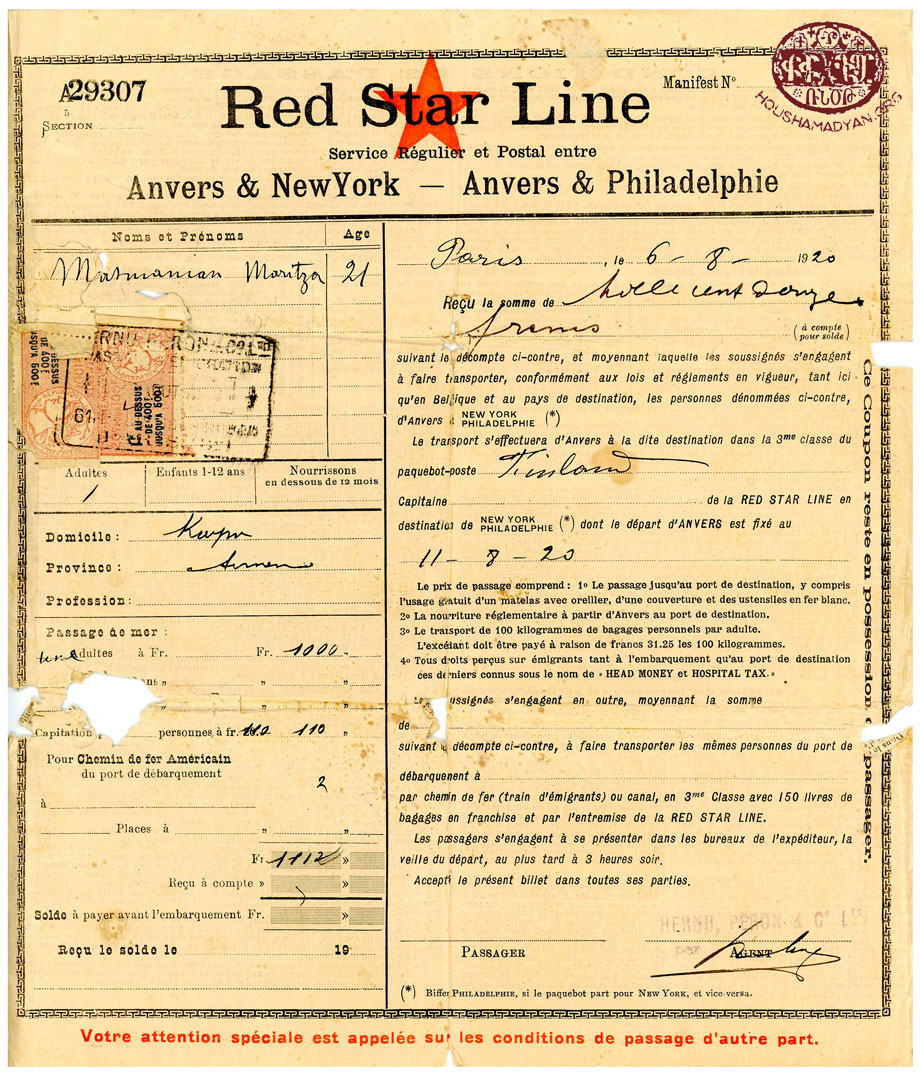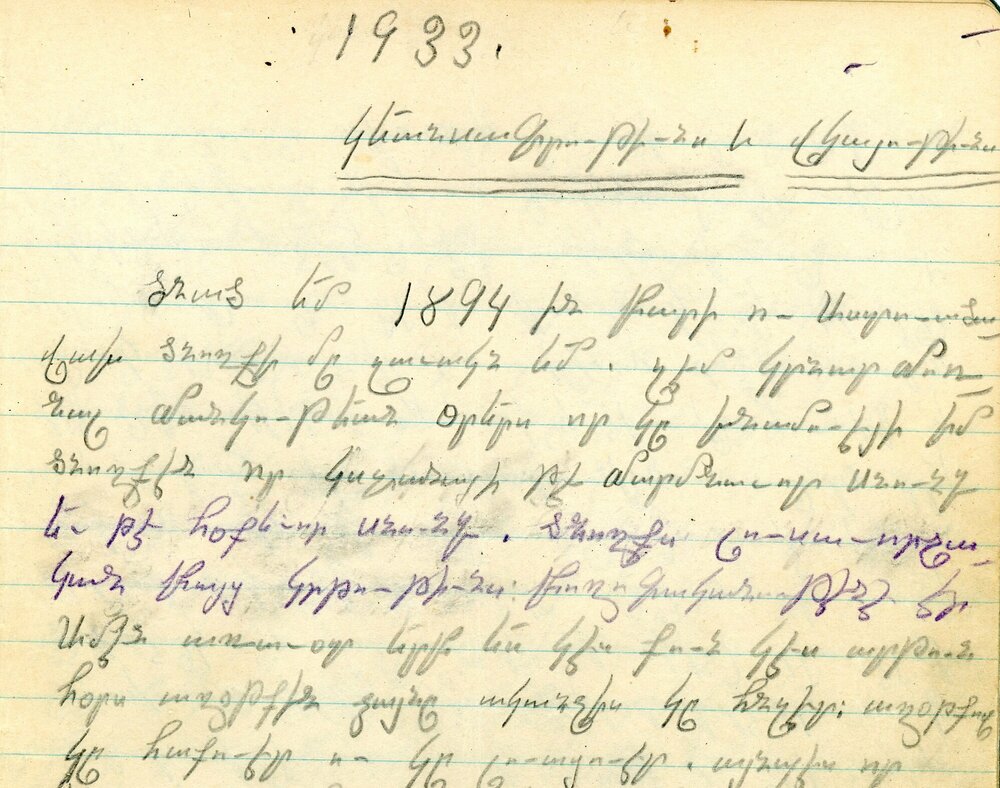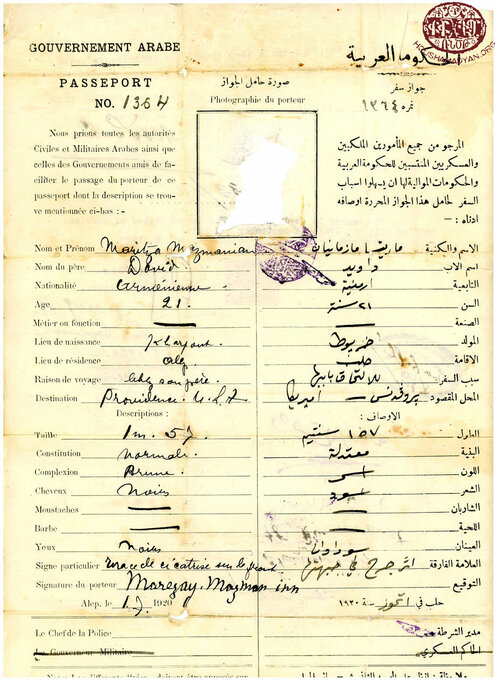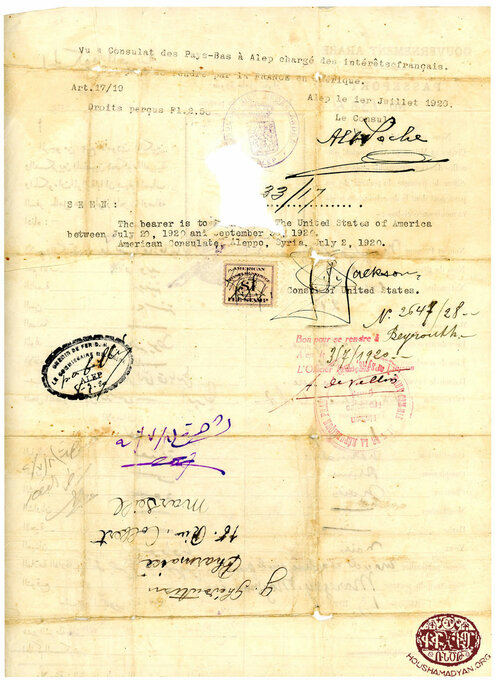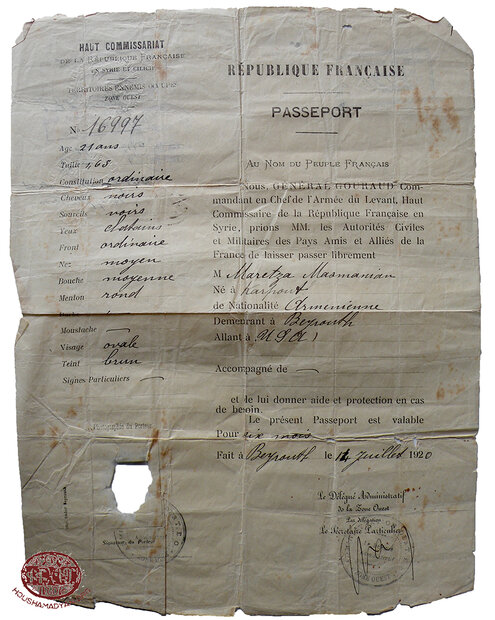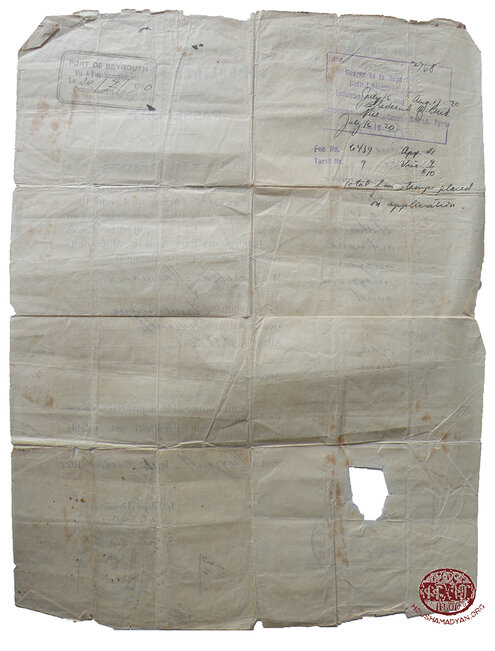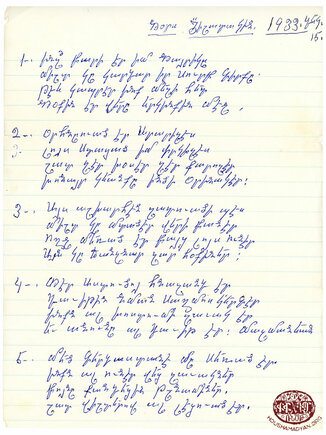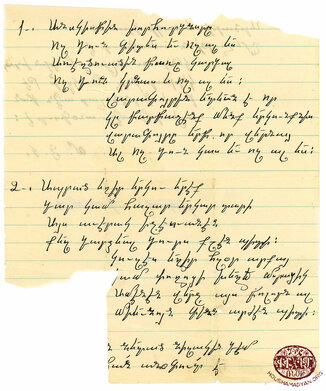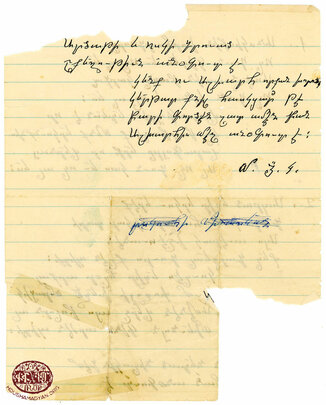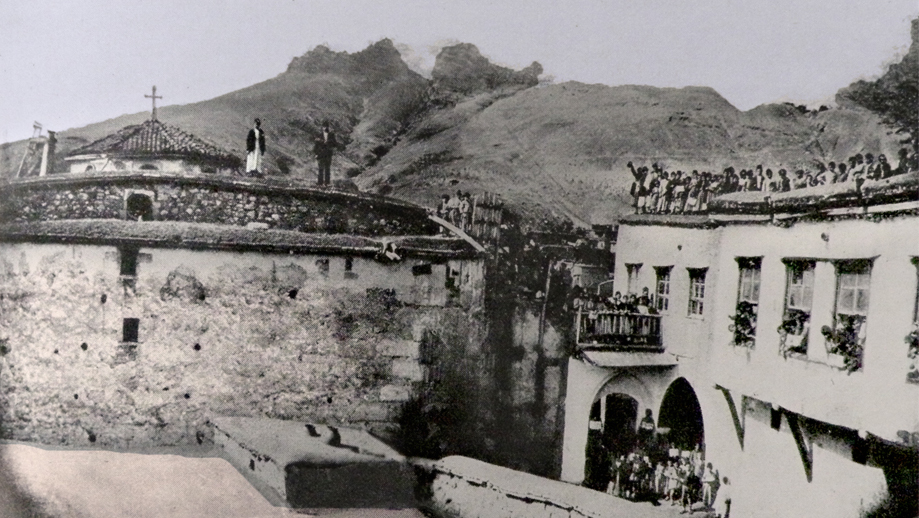Goshgarian-Calusdian Collection, Falmouth, MA

On this page, we present material that the Goshgarian/Calusdian family has made available to us. The family’s ancestors came from the plain of Kharpert (the town itself, Mamuret-el-Aziz, Hiusenig, Shntil) and the town of Malatya.
Hovagim, of the family’s Goshgarian branch, was born in the village of Shntil. At the turn of the twentieth century, he traveled to the United States in search of employment, with the intention of returning to his fatherland with his earnings and living a relatively comfortable life there. After working for years as an unskilled laborer in a mine and factories and accumulating some savings, he returned to Shntil, where he married. Two or three years later, he set out for the United States again, leaving his wife and two sons behind in his native village; they were to disappear in the Genocide. On two occasions, in 1909 and again in 1910, he bought land in Shntil and the vicinity. These transactions were carried out in the United States; they were notarized by an American notary public and also officialized by the Ottoman consulate in New York. But the Genocide that began a few years later shattered Hovagim’s plans. Throughout those fateful years, Hovagim was in the United States.
The original documents attesting Hovagim’s real-estate transactions are held by the Goshgarian/Calusdian family. We present these exceptional documents on this page.
In the United States, Hovagim Goshgarian remarried. His second wife, Maritsa Mazmanian, was a native of Husenig. Maritsa was born around 1892. Her father, Tavit Mazmanian, born in 1856, was a butcher in Husenig. Her mother’s maiden name was Vartig Kibarian. Vartig and Tavit had six daughters: Maritsa (later Goshgarian), Azniv (later Danielian), Satenig (later Agnezian), Siroun (later Mosoian), Araksi (later Tashjian), and Yeghsapet (later Hougazian, thereafter Shadbegian). Maritsa’s mother perished in 1915. Maritsa herself escaped the deportation at the price of a forced marriage, from which she fled with the help of American Protestants at war's end, leaving a young daughter behind. Her sisters, too, survived the Genocide and, like Maritsa, all eventually settled in Worcester, Massachusetts. We find Maritsa in Aleppo in the immediate post-Genocide years. From there she traveled to Lebanon and on to Marseille, France, where she boarded ship for the United States.
Hovagim and Maritsa married in Worcester around 1922. They had two children, Kourken (George) and Vart (Rose).
Hovagim’s and Maritsa’s son Kourken (George) Goshgarian married Zabel (Isabel) Calusdian in the United States. Isabel’s mother, Hayganoush (née Gosdanian), came from the town of Kharpert. Her first husband was Mgrdich Boghosian. She bore him three children, Zabel, Lusine, and Yevgine. Hayganoush was the only one of her family to survive the Genocide; her husband was killed near Mamuret-el-Aziz (Mezireh) in June 1915, and her three daughters died during the deportation. From 1915 to 1918, Hayganoush was in Aleppo, where she found work in a Christian Arab family. At war’s end, she returned to her family home in Kharpert, where she remained for some six months, sharing the house with a distant relative, Hrach Holopigian, who would soon migrate to Soviet Armenia. In 1921 or 1922 she settled in the United States, where she remarried. She and her second husband, Assadour Calusdian of Malatya, had one daughter, Zabel (Isabel) Calusdian (later Goshgarian).

The Gosdanian Branch of the Family
Kharpert/Harput, around 1915. A photograph of the family of Hayganoush Calusdian (née Gosdanian), including Menduhi, Hayganoush’s sister, their mother Yeghnar “Ana” Gosdanian (née Adamian), and their maternal aunt, Tourundj Adamian.
The five children in the first row, from left to right: Garabed Margosian (Aghavni's son); unknown child (on lap); Manduhi Gosdanian (later Chechian; the name Chechian was changed to Engin); Sarkis' son (name unknown); unknown child. Seated, left to right: Garabed ("Asdergak") Keldjikian; Tourundj Atamian Keldjikian; Yeghnar "Ana" Gosdanian (née Atamian). (Touroundj and Yeghnar were sisters).
Standing in back row, left to right: Aghavni Keldjikian Margosian (later Balian, Garabed's mother); 2-5 Keldjikian daughters or Keldjikian daughters-in-law or Keldjikian sons or Keldjikian sons-in-law. One of the women is Sarkis' wife. She is probably standing next to Sarkis; 6th from the left, Sarkis (Yeghnar's adopted son).
The Gosdanian family from the town of Harput/Kharpert. Left to right: Aghavni Gosdanian (daughter), Yeghnar "Ana" Gosdanian (née Atamian, mother), Dikran Gosdanian (son), Krikor Gosdanian (father), Hovhannes Gosdanian (uncle – Krikor’s brother), Hovhannes’ wife (name unknown), Azniv Gosdanian (Hovhannes’ daughter).
Aghavni Gosdanian, the young girl on the far left, is Hayganoush Gosdanian’s (Isabel’s mother’s) sister. Yeghnar "Ana" Gosdanian is Hayganoush’s mother, and Dickran Gosdanian is Hayganoush’s elder brother. Hovhannes Gosdanian is Hayganoush’s paternal uncle.
Hayganoush had three sisters besides Aghavni: Nargiz (c. 1896-1915), Veronika (c. 1894-1915), and Mendouhi (1908-1990), none of whom is to be seen in this photograph. Nargiz and Veronika, both married, each had one daughter. Veronika, Nargiz, and Nargiz’s daughter perished in the course of the deportation. Mendouhi and Veronika’s daughter Razmouhi survived the Genocide.
Aghavni had given birth to a son, Garabed, by the time of the Genocide. He was killed in 1915, and his mother, overcome by grief, committed suicide. Hayganoush's elder brother Dickran was also killed in 1915. Karekin was adopted by a Kurd in these years of deportation and massacre; he lived in Kharpert until the 1950s, when he moved to Istanbul. Mendouhi spent her life in Kharpert, dying in 1990. Hayganoush kept up a correspondence with her brother until his death in 1960, and with Mendouhi until the 1980s. Hayganoush died in Connecticut, USA in 1984.
There is reason to believe that the photographer who produced this family picture, Ghazaros Melikian, a Kharpert native later active in Worcester, combined two different photographs at Hayganoush’s request.
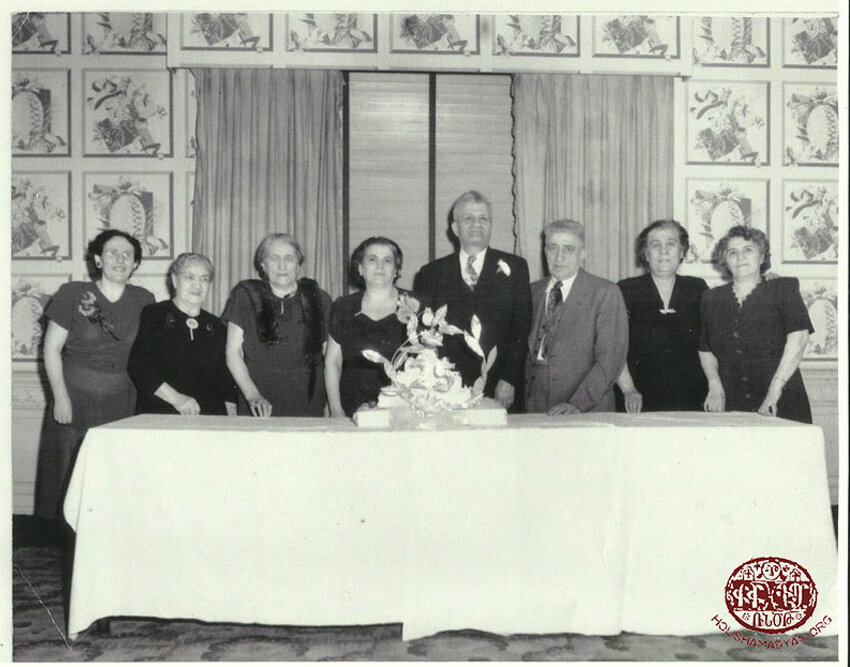
Arakel Gosdanian and Anna Gosdanian (née Casperian) (in the center of the photograph) at their twenty-fifth anniversary celebration. Hayganoush Calusdian (née Gosdanian) is second from the right.

The records the family listened to
The Gosdanian/Calusdian and Goshgarian/Mazmanian families listened to these Armenian songs in the United States from the 1920s on. Released on records distributed in the U.S., these songs were very often the work of Armenian singers and songwriters born in Kharpert or elsewhere in the Ottoman Empire. We have other songs at our disposal – not published on this page – most of which were recorded in Soviet Armenia. These were classical love songs or patriotic songs. They too were frequently heard in the homes of the people memorialized on this page.

The Calusdian/Bournazian branch of the family
Hayganoush arrived in the United States around 1920. Here she remarried, bearing her second husband, Assadour Calusdian, a daughter, Isabel (Zabel) Calusdian (later Goshgarian). One of Hayganoush’s three daughters from her first marriage, all of them killed in 1915, had also been named Zabel. Assadour Calusdian had a sister named Varter, who married Krikor Bournazian of Malatya.
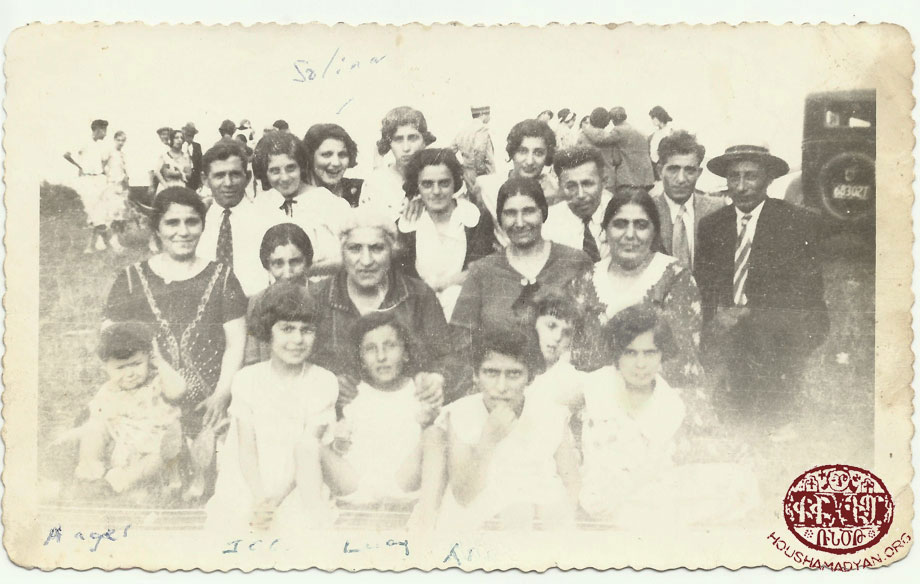
A group photo including Isabel (Zabel) Calusdian (later Goshgarian, front row, second from the left) and her cousins Lucy Gosdanian (later Grant), third from the left, and Dorothy (Anna) Gosdanian (later Mossessian), Nishan and Ovsanna Yalian Gosdanian's daughters. Lucy Gosdanian went on to become a singer well-known to the Armenian community in Massachusetts, often performing with her husband Cortland Grant under the stage name Lucille Dane.
A pocket notebook that belonged to Assadour Calusdian, the husband of Hayganoush Calusdian (née Gosdanian). Assadour was a native of Malatya. In the United States, he was a supporter of Soviet Armenia and a member of the Committee for Armenian Assistance (Hay Oknutyan Gomide, or HOK), an organization that had the Yerevan government's approval. The poems and songs copied in his pocket notebook reflect his political orientation. Thus we find copies of work by two poets who often sang Soviet Armenia’s praises, Garabed Sidal (an active member of the Communist Party USA) and Kegham Sarian. The notebook also contains texts by Anzhel Srabian (née Chilingirian), a teacher from Istanbul who settled in Paris and then Worcester, where she gave Isabel (Zabel) Calusdian (later Goshgarian) Armenian lessons. One of Anzhel’s poems is dedicated to Zabel. Composed around 1933, it bears the title “My True Love.”
To view a PDF of every page in Assadour’s notebook, click on the photograph above.

The Goshgarian branch of the family
Hovagim Goshgarian came from the village of Shntil (present-day Bahçekapı) on Kharpert’s “Golden Plain.” In the early 1900s he set out for the United States, where he worked in a mine and various factories. His wife and two sons lived in Shntil. Hovagim planned to return to his native village after working in the United States, using the money he had saved there to improve his family’s lot.
On this page, we present a number of documents that belonged to Hovagim Goshgarian, including land deeds.
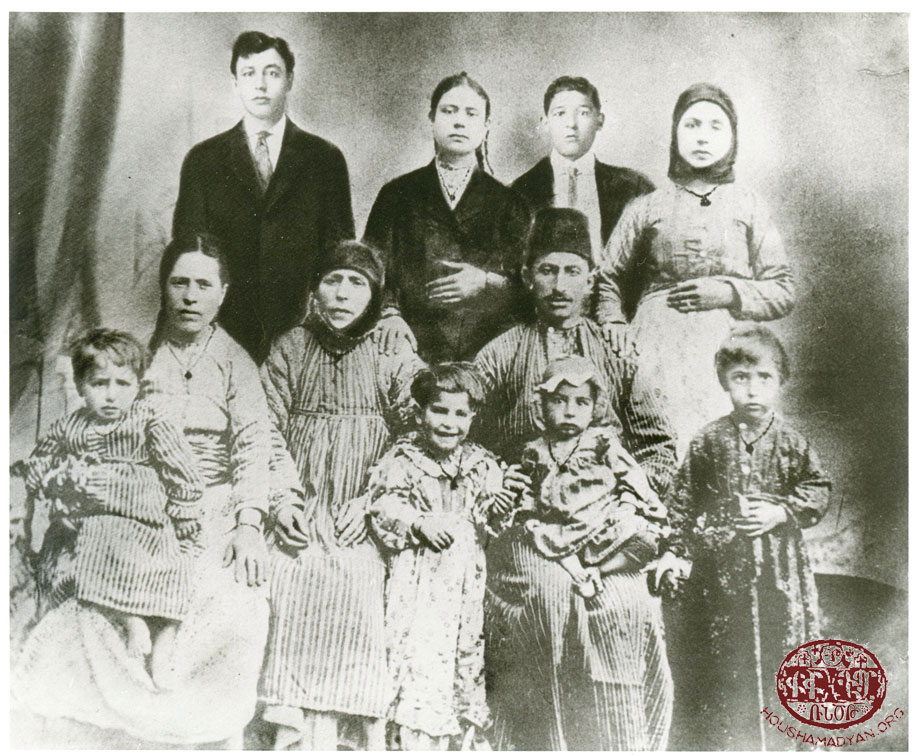
The Goshgarian family in Shntil. Standing, from left to right: Hovagim Goshgarian; Hovagim’s sister Marie Mushakhian (née Goshgarian): Hovagim’s cousin Markar Goshgarian; and Hovagim’s sister Sultan Bournazian (née Goshgarian). Obviously, Hovagim and Markar were belatedly added to the original photograph.
In the forefront, from left to right: Hovagim’s first wife (her name is unknown); one of Hovagim’s two sons (on his wife’s lap); Shoushan Goshgarian (Hovagim’s mother); Hovagim’s other son from his first marriage, Kurken Goshgarian (the smiling boy standing to Shoushan’s right); Bournazian (first name unknown), with his son, Hovhannes Bournazian, on his lap; and Krikor Bournazian (standing on his father’s right). This Krikor Bournazian, from Shntil, should not be confused with his namesake from Malatia, who married Assadour Calusdian’s sister.
Hovagim Goshgarian’s Ottoman passport, issued by the Ottoman consulate in New York in November 1910. We know that Hovagim, who was in the United States in 1910, went back to Shntil once. He probably obtained this passport in order to make that return trip. In 1913, he again set out for the U.S. He was thus saved from the Genocide. The story goes that he undertook this second voyage to dodge the Ottoman draft during the Balkan Wars and so avoid being sent to the front with the army. His wife and sons, who remained in Shntil, disappeared without a trace in 1915. According to his passport, Hovagim was twenty-nine years old in 1910.
Hovagim Goshgarian’s Ottoman passport, in French and Ottoman Turkish. Some time after November 1910, Hovagim went back to Shntil, later leaving for the United States again. Plainly, this passport, issued on 4/17 March 1913, enabled him to leave the Ottoman Empire and re-enter the United States. The passport further indicates that the bearer was leaving the Ottoman Empire for “Ostour”. The Armenian immigrants pronounced the name of the city of Worcester “Ousdr.” “Ousdr” was presumably further distorted by the Turkish clerk who prepared the passport, becoming "Ostour."
This property deed belonged to Hovagim Goshgarian. Drawn up on 26 November 1909, it was notarized by an American notary public and officialized by the Ottoman consulate in New York.
The deed confirms that Hovagim Goshgarian of the city of Worcester, Massachusetts purchased, for two hundred dollars, a number of tracts of land from Krikor Der Minassian of Milford (a town not far from Worcester).
This document too is a property deed notarized by an American notary public and officialized by the Ottoman consulate in New York. Very probably, it bears some connection to Hovagim Goshgarian’s real-estate transactions. It is here stated that Krikor Garabedian of the city of Worcester authorizes Garabed Hovhannessian of the village of Shntil (in the Kharpert region) to transfer title to various lots of land to Hovagim Khachadurian. The lots’ boundaries are very precisely defined in the document, which is dated 2 February 1910.

The Mazmanian Branch of the Family
The Mazmanian family was from Husenig. In the United States, Maritsa Mazmanian married Hovagim Goshgarian (from the village of Shntil). Their son George (Kourken) married Isabel (Zabel) Calusdian. They had three children, Geoffrey Michael, Claudia, and George.
On this page, we also present a recording of Maritsa’s recital of her poems about the church in Husenig and its bell.
“The Church in Husenig” by Maritsa Goshgarian (née Mazmanian)
A photograph of Husenig’s Varvara Church. The Armenian school may be seen on the right. (Mardiros Deranian collection, NAASR, Belmont, Massachusetts).
Poem written and recited by Maritsa Goshgarian (née Mazmanian).
1845-ին
Հիմը դրուած էր այս շէնքին,
Հայկազունեաց որդիները
Կը յեղկէին մեծ քարերը:
Որմնադիրները մէկ կողմէն,
Գործաւորները չորս կողմէն,
Քար քարի վրայ կը շարէին,
Այս մեծ շէնքը կը շինէին:
Տուած էին ձեռքեր ձեռքի,
Միացած էր սրտեր սրտի,
Նպատակ կար անոնց մէջը,
Արդիւնք մը կար անոր վերջը:
Երկար օրեր աշխատեցան,
Շատ քրտինքներ հոն թափուեցան,
Եւ վերջապէս յաջողեցան
Կանգնել այս եկեղեցին աննման:
Յետոյ եկաւ մեծ կոտորած,
Թուրքեր, Քիւրտեր զէնքեր առած,
Կը զառնէին, կը սպաննէին,
Հիւսէնիկը կ՚աւերէին:
Եկեղեցին կողոպտեցին,
Աս կոչնակն ալ վար նետեցին:
Ո՛վ՜ Հիւսենիկ – եկեղեցիդ,
Որ միացած էր դպրոցիդ,
Կամարներով շրջապատուած,
Չորս սիւներով էր հաստատուած:
Ի՛նչ հոյակապ շինուածք էիր,
Քեզ տեսնողին զարմանք էիր,
Փառաւոր էր տաճառներդ
Եւ վառվռուն՝ կանդարներդ:
Հարուստ-աղքատ հոն կու գային,
Հօր Ատտուծոյ կ՚աղօթէին,
Ոմանք ձայնով, ոմանք լալով,
Կ՚աղօթէին ահով-դողով:
Շարականներ ու մելետներ
Քաղցր ձայներ հոն կ՚երգուէր,
Քահանաներ իրենց կարգին
Կ՚աղօթէին պաղատագին:
Ուխտաւորներն ալ կու գային
Եւ նուէրներ կը բերէին:
Կար մէջը անոնց՝ կոյրեր, խուլեր,
Եւ շատ տարբեր ցաւագարներ:
Խորաններու առջեւ ինկած
Եւ ոմանք ալ բազկատարած,
Մեծ հաւատքով կը խնդրէին
Եւ ցաւերը կը յայտնէին:
Կային այրեր, կային կիներ,
Աստուած միայն անոնց յոյսն էր:
Երկնաւոր Հօր փառք կու տային,
Բժշկութիւն կը խնդրէին:
Այսպէս ամեն հաւատացեալ
Կ՚ըլլայ Հօրը շնորհակալ:
Իրենց տուները երբ դառնային,
Չէին մոռնար եկեղեցին:
Անհետացան այս լաւ օրեր,
Քանդուեցան եկեղեցիներ,
Նահատակուեցան մեր սիրելիներ:
Վէրքեր ունինք մենք մեր սրտեր:
Բժիշկն է Աստուածը մեր:
Սիրելի՛ հայրենակիցներ,
Հաւատքով Աստուծոյ աղօթենք,
Եւ մեր ցաւերը ողջը տանենք,
Յիսուսի պէս խաչ կրել սորվենք,
Որ, որ, համբերանք ... համբերանք ... համբերանք ...
“Husenig’s Church Bell” by Maritsa Goshgarian (née Mazmanian)

A photograph of the church bell in Mezire’s German orphanage.
Poem written and recited by Maritsa Goshgarian (née Mazmanian).
1892-ին
Ամերիկահայեր կոչնակ մը խրկեցին (ղրկեցին),
Մեր նախահայրերն այդտեղ կախեցին,
Ուրախութիւնը վեր ընդարաւերեցին(?)։
Ի՜նչքան ուրախալի էր այն օրը,
Ո՜րքան քաղցր էր անոր ձայնը։
Երբ որ հնչէր այս կոչնակը
Կը սասանէր Հիւսէնիկը։
Թուրքեր այս ձայնը երբ լսեցին,
Նախանձներ ու ոխ յայտնեցին։
Ասոր համար շատ նեղուեցան,
Հայերուն դէմ քրքրուեցան։
Պատեհութիւն կը փնտռէին,
Որ անոր ձայնը կտրէին,
Եւ վերջապէս յաջողեցան
Շուտ բերելու անոր վախճան։
Երկու տարի միակ անցաւ
Եւ անոր ձայնը թաւշեցաւ,
Տարի մըն ալ անձայն մնաց,
Ու իր տեղը կախուած մնաց։
Յետոյ եկաւ մեծ կոտորած,
Թուրքեր, քիւրտեր զէնքեր առած,
Կը զառնէին, կը սպաննէին,
Հիւսէնիկը կ՛աւերէին։
Եկեղեցին կողոպտեցին,
Այս կոչնակն ալ վար նետեցին,
Որ վերջապէս առին տարին,
Արջառներու մսուր ըրին։
Ո՜վ Հիւսէնիկ գիւղաքաղաք,
Է՜իր մեզի մայրաքաղաք,
Մեր հայրերու ծնունդավայր
Եւ շատերու բնակավայր։
Ո՜վ Հիւսէնիկ, դուն մի ըղձանք,
Շատ տարիներ եղար հրճուանք
Բոլոր անոնց, որ ծնեցան
Եւ քու դաշտերուդ մէջ ապրեցան։
Ո՜վ Հիւսէնիկ, քու զաւակներդ,
Որոնց սրտին մէջն է սէրդ,
Ամէն անգամ քեզ որ յիշեն,
Իրենց սրտէն ախ կը քաշեն։
Ո՜վ Հիւսէնիկ, ինչպէ՞ս մոռնանք,
Քանզի դուն ես մեզի պարծանք,
Եւ մէկ հատիկ Խարբերդի մէջ
Կը սփռէիր լոյս մը անշէջ։
Ո՜վ Հիւսէնիկ, այգիներդ
Այգեկութքի մեծ օրերդ,
Որքա՜ն արտեր կ՛ընէր զուարթ
Եւ երջանիկ էր ամէն մարդ։
Ո՜վ Հիւսէնիկ, քու պարտէզներդ,
Անոր մէջի պտուղներդ,
Եւ գոյնզգոյն խոտուտ վարդեր,
Ամէն տեսնողը կը զմայլէր։
Ո՜վ Հիւսէնիկ, Եոթ Մագլերդ
Որուն մէջէն կ՛ելլէր ջուրդ,
Ապառաժէն վար կը վազէր,
Բոլոր դաշտդ ան կ՛ոռոգէր։
Ո՜վ Հիւսէնիկ, Տեղէտանում(?)
Զոր ջուրերը կ՛երթար սահուն,
Վերմակի պէս կանաչ խոտեր
Չորս կողմերդ կը տեսնուէր։
Մոռենիկէն երբ դառնային
Ամէն Զատկի Մեծ հինգշաբթին,
Ուրախութեամբ վառ կը դառնար,
Մինչեւ արեւը մարը մտնար։
--[ժապաւէնը] լմնցաւ։ Ալ չկայ։
--Too bad:

